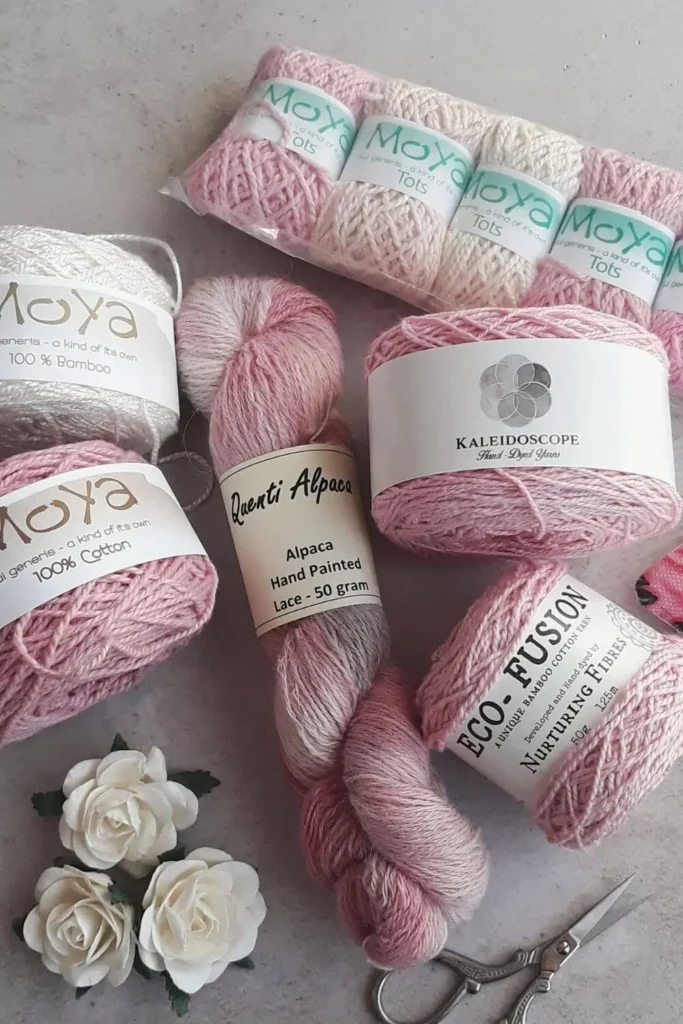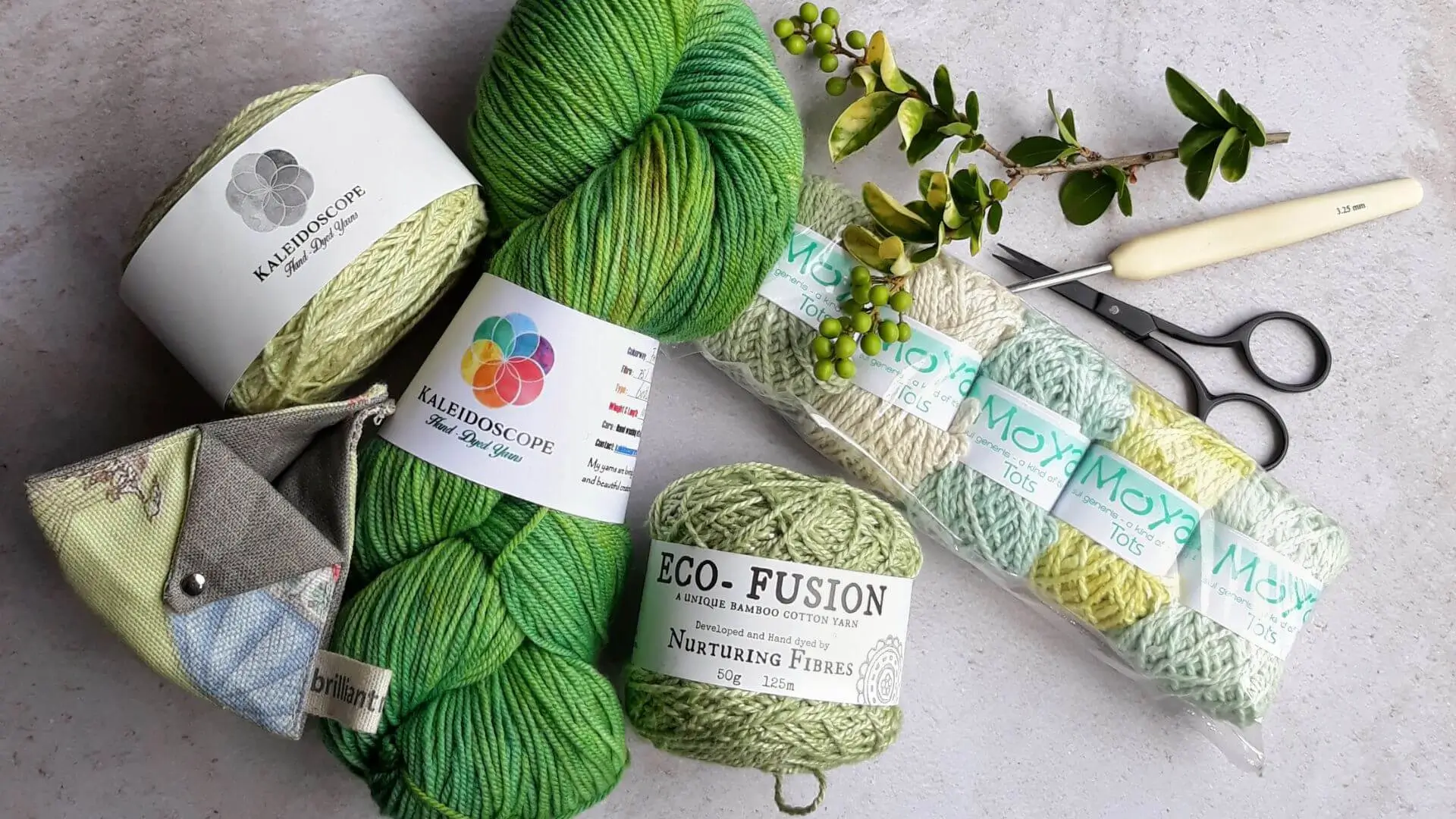Ever picked up a knitting or crochet pattern and felt like it was written in another language? The world of yarn crafts comes with its own special set of yarn terms, abbreviations, and phrases that can feel overwhelming at first.
If you are new to knitting and crochet, consider starting with The Ultimate Yarn Crafts Guide for a comprehensive introduction to the hobby. This resource consolidates all the foundational information you need, from how yarn is constructed (ply) to its thickness (weight) and the terminology used in patterns, into one simple resource.

Part I: Yarn Weights Explained (Thickness and Categories)
The yarn weight describes the thickness of the yarn and is the most important factor in determining your needle or hook size and the overall drape of the finished fabric.
The Craft Yarn Council (CYC) has simplified this process with a standardized yarn weights system, making it easier to follow patterns, substitute yarns, and select the best material for your creations. Weights are numbered 0 (finest) to 7 (thickest), ensuring consistency across brands and patterns.
The Standard Yarn Weights System: A Detailed Breakdown
The table below breaks down the CYC’s standard yarn weight categories (0–7) with recommended tooling, typical gauge, and project ideas.
| Symbol | Category | Typical Yarns | Needle Size (US) | Hook Size (US) | Gauge (4”/10cm) (Knit) | Best For |
| 0 | Lace | Cobweb, thread, 10-count crochet thread | 000–1 (1.5mm–2.25mm) | B-1 (2.25mm) | 33–40+ stitches | Shawls, doilies, lightweight scarves |
| 1 | Super Fine | Fingering, Sock, Baby | 1–3 (2.25mm–3.25mm) | B-1 to E-4 (2.25mm–3.5mm) | 27–32 stitches | Socks, lightweight sweaters, baby clothes |
| 2 | Fine | Sport, Baby | 3–5 (3.25mm–3.75mm) | E-4 to 7 (3.5mm–4.5mm) | 23–26 stitches | Baby blankets, lightweight sweaters, socks |
| 3 | Light | DK (Double Knitting), Light Worsted | 5–7 (3.75mm–4.5mm) | 7 to I-9 (4.5mm–5.5mm) | 21–24 stitches | Sweaters, cardigans, lightweight blankets |
| 4 | Medium | Worsted, Aran, Afghan | 7–9 (4.5mm–5.5mm) | I-9 to K-10½ (5.5mm–6.5mm) | 16–20 stitches | Sweaters, blankets, scarves, hats |
| 5 | Bulky | Chunky, Craft, Rug Yarn | 9–11 (5.5mm–8mm) | K-10½ to M-13 (6.5mm–9mm) | 12–15 stitches | Cozy sweaters, blankets, rugs, quick projects |
| 6 | Super Bulky | Super Bulky, Roving | 11–17 (8mm–12.75mm) | M-13 to Q (9mm–15mm) | 7–11 stitches | Thick blankets, chunky scarves, arm-knitted projects |
| 7 | Jumbo | Jumbo, Roving | 17+ (12.75mm+) | Q+ (15mm+) | ≤6 stitches | Giant blankets, rugs, floor poufs |
Part II: Yarn Ply and Texture
Yarn ply refers to the number of individual strands (singles or plies) twisted together to form the final yarn. This structure dramatically affects the look, feel, and durability of your finished project.
A common misconception is that yarn ply equals yarn weight. While in some regions (like Australia and New Zealand) “8-ply” is used to describe yarn thickness (DK weight), the term “ply” internationally refers to the number of strands, not the weight category. Always check the yarn label for the CYC weight number (0–7) for accuracy.
How Yarn Ply Affects Projects
Understanding ply is crucial for successful crafting:
- Durability: More plies generally result in stronger yarn that is less prone to pilling or breaking.
- Stitch Definition: Multi-ply yarns are typically rounder and show off complex stitch patterns, like cables and lace, beautifully.
- Drape and Texture:
- Low-Ply (1–2): Softer texture, less twist, and more prone to fuzziness or halo, which is great for delicate lace shawls.
- High-Ply (4+): Smooth, strong, and creates structured, crisp shapes, making them ideal for durable garments and textured stitch work.
Yarn Texture
Texture is the yarn’s surface feel (smooth, fuzzy, boucle, slub, or chainette) and is the hidden partner of ply. For instance, a smooth 4-ply cotton will give very defined stitches, while a boucle 4-ply wool will have a soft, irregular surface, even though the ply count is the same.
Part III: Key Yarn Terms and Lingo
These are the essential yarn terms and abbreviations you will encounter in knitting and crochet patterns, on labels, and within the crafting community:
Pattern Abbreviations
| Craft | Term | Abbreviation | Definition |
| Knitting | Knit | k | The most basic knitting stitch. |
| Knitting | Purl | p | The reverse of the knit stitch. |
| Knitting | Knit Two Together | k2tog | A basic decrease stitch. |
| Crochet | Chain | ch | The base of most crochet projects. |
| Crochet | Single Crochet | sc | A short, dense, and sturdy crochet stitch. |
| Crochet | Double Crochet | dc | A taller, airier crochet stitch. |
Yarn Formats and Quantities
| Term | Definition |
| Skein | Oblong-shaped yarn that is ready to use, usually pulled from the center or outside. |
| Hank | A large, twisted loop of yarn that must be wound into a ball or cake before use to prevent tangling. |
| Ball | Yarn wound into a rounded shape, often used for smaller quantities. |
| Cake | Flat-bottomed, center-pull yarn, typically wound with a mechanical winder. |
| Dye Lot | The specific batch in which the yarn was dyed. Always buy enough yarn from the same lot to ensure consistent color. |
Project and Technique Terms
| Term | Definition |
| Gauge | The number of stitches and rows per inch (or centimeter) in your project. Matching the pattern’s gauge is vital to ensuring the finished piece is the correct size. |
| WIP | Stands for “Work In Progress” — any project you have started but haven’t finished yet. |
| Notions | Small tools required for a project, such as stitch markers, tapestry needles, or row counters. |
| Blocking | The final process of shaping and setting the stitches of a finished project, usually by steaming, wetting, or spraying and pinning the item into place. |
| Frogging | Ripping back stitches (so called because you “rip-it, rip-it” out of the project) when a mistake is made. |
| Superwash | A special treatment for wool that allows it to be machine-washed without the fibers felting or shrinking. |



